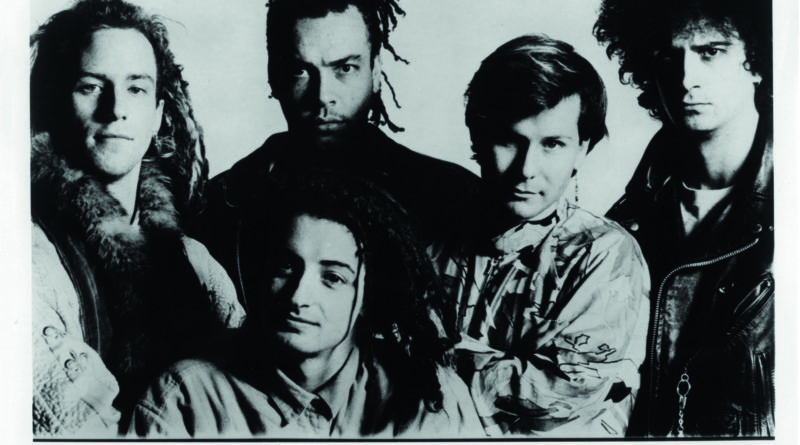No Small Victory
A Playlist Companion to New Faith No More Book

“It was how Captain Beefheart might sound if he went punk-metal.” That’s how the L.A. Times described Faith No More’s sound in a December 1984 concert review. “Kind of ‘gothic rap’” read another review from Maximumrocknroll that same year.
From its early-’80s origins, according to Adrian Harte’s new Jawbone Press biography Small Victories: The True Story of Faith No More, the iconic San Francisco quintet self-consciously stitched together aesthetic elements that the band knew would be received with distaste within the punk and hardcore circles in its native Bay Area. But even as it began to win people over, Faith No More’s hallmark combination of rock, funk, post-punk, and metal (with splashes of goth and avant-garde experimentation thrown-in for good measure) confounded as much as it delighted.
The book attributes the band — and late former vocalist Chuck Mosley in particular — as the origin point of rap-rock. Mosley and keyboardist Roddy Bottum both cede that honor to Run-DMC, but any way you slice it, Faith No More were onto something. Guitarist Desmond Shea, who played in the band briefly as a teenager, recalls in the book that “they were a dynamic, machine-like system, and I had never heard anything like them. [They] incorporat[ed] minimal, industrial, and dub elements into what might be called ‘new metal’ [sic] or ‘rap rock’ or ‘alternative metal’ ten-plus years later.”
Once the core foundation of bassist Billy Gould, drummer Mike Bordin, and Bottom was set, Faith No More became something of a manticore-like creature both musically and, in a sense, literally as well. Harte quotes one-time tour manager/sound technician Tim Dalton as saying: “I was taken aback by this strange collection of people that shouldn’t fit together.”
Naturally, Faith No More’s ascension to household-name status during the alternative era was, well… no small victory. Their one-time manager Warren Entner sized them up as follows: “I like to think the aim is a college audience,” he told Billboard in 1987, “but they’re not solely that type of band. Any kid who likes Metallica or even The Clash will like this band.” His next comment was also telling: “The way to break an act has gotten so sophisticated and so expensive, but this reminds me of how the music industry used to be — if you like something, you stick with it and watch it develop into something.”
Exhaustively researched (with quotes from just about everyone who ever served as a band member) Small Victories chronicles Faith No More’s complicated, winding journey. To paraphrase Harte, the band’s history, like their music, followed a decidedly non-linear path that along the way featured appearances by the likes of Metallica bassist Cliff Burton, Hole frontwoman Courntey Love, Soundgarden frontman Chris Cornell, Paula Frazer of Tarnation and Los Lobos saxophonist/producer Steve Berlin, to name just a few. Harte captures the whole story, along with innumerable detours, in rich prose that makes for a hell of a satisfying read and will have you turning pages long past the point you intended to put the book down. (There’s also plenty here for readers already familiar with Steffan Chirazi’s 1994 biography Faith No More: The Real Story. Even Billy Gould himself has proclaimed, “It provided me with more than a few revelations — and I’m in the band.”)
To accompany the release of Small Victories, Rock and Roll Globe presents a playlist named after the book. The intention is for unfamiliar listeners and hardcore fans alike to discover new things in this set of songs. Forgive me if the zig-zagging turns occasionally interfere with the lyricism of Harte’s writing, but it was the eclecticism of Faith No More’s music that presented such a satisfying challenge, i.e: how does one find flow in the catalog of a band that prided itself on its sense of adventure?
I purposely chose not to assemble the track sequence in chronological order. Though that approach would certainly have highlighted the band’s growth over time, I thought Faith No More’s range was better served if I treated this more like a live setlist where the band gave itself room to push back against predictable expectations for certain songs by not pandering to the obvious.
At the end of the day, artists — if they’re lucky enough to be remembered at all — are remembered for a tiny subset of their work that doesn’t adequately represent what they achieved. It’s the nature of the beast that legacies get reduced to the soundbyte-length blurbs we chisel into the public’s memory like tombstone engravings. In Faith No More’s case, though, even a collection of singles would tell us quite a bit about who the band was. That said, their body of work entices like an exotic landscape teeming with strange sounds just beyond the safe confines of a resort area — I highly recommend listening on repeat, with the songtitles out of view to maximize the element of surprise.
More than that, I recommend picking up Harte’s book immediately — provided you have a few hours to spare.




